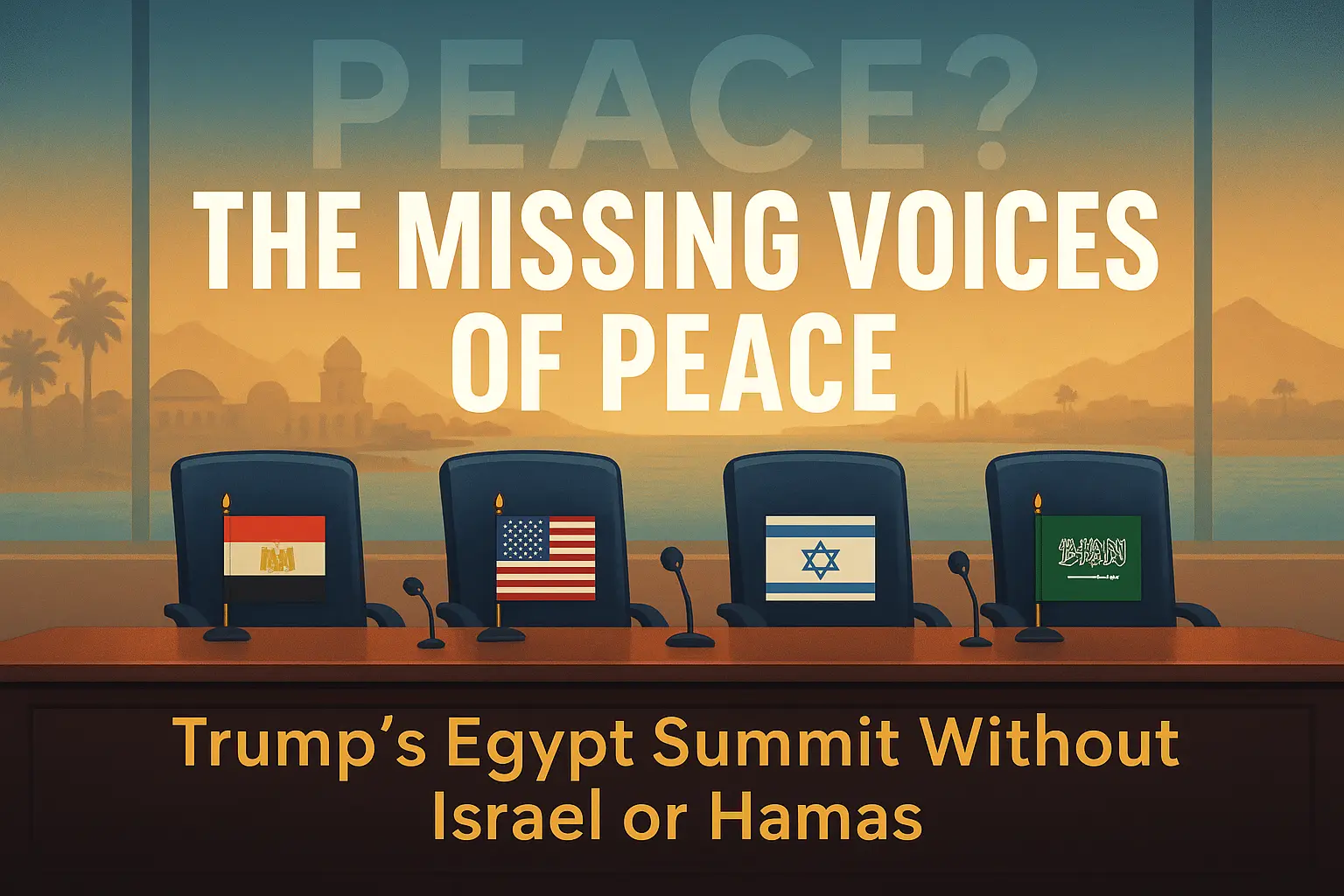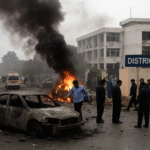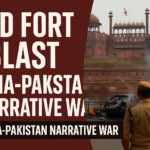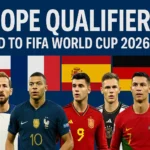By Ch Haroon Rashid
In a moment broadcast worldwide as a turning point for Middle East peace, former U.S. President Donald Trump arrived in Sharm el-Sheikh, Egypt, for what was billed as a historic peace summit to end the Gaza war. The event was monumental in optics — a lineup of world leaders, flags, and international pledges — but the substance told a more complex story.
Two empty chairs cast long shadows across the hall: those of Israeli Prime Minister Benjamin Netanyahu and Hamas leadership.
Both the key stakeholders of the Gaza conflict were missing from a pact meant to end it.
Netanyahu refused to attend, objecting to the two-state references in the draft framework and resisting any formal recognition of a Palestinian state. Hamas, excluded by design, dismissed the process outright as “an illegitimate American show.”
The irony is unmistakable — a peace pact without its principal belligerents, signed by mediators and observers who must now carry the moral burden of enforcing it.
Trump’s Diplomatic Showpiece in Egypt
The Sharm el-Sheikh summit was Trump’s most visible foreign policy initiative since returning to office. Alongside Egypt’s President Abdel Fattah el-Sisi, Qatar’s Emir Sheikh Tamim bin Hamad Al Thani, and Turkey’s Foreign Minister Hakan Fidan, Trump presided over the signing of a Gaza ceasefire and reconstruction framework.
The atmosphere was carefully choreographed: leaders standing shoulder to shoulder, the word PEACE projected across the conference backdrop, and television networks carrying Trump’s speech live across multiple continents.
“This is the moment of decision for the Middle East,” Trump declared. “We can choose to keep fighting old wars, or we can start building a new peace.”
Yet behind the grandeur lay a harsh geopolitical reality — neither Israel nor Hamas were willing to co-sign that promise.
Inside the Sharm el-Sheikh Peace Framework
Despite the absences, the summit produced a formal declaration co-signed by Egypt, Qatar, Turkey, and the United States — the four key mediators of the recent truce. The document’s core points included:
•Immediate and total ceasefire between Israel and Palestinian armed factions.
•Gradual withdrawal of Israeli forces from Gaza, tied to verified compliance milestones.
•Humanitarian corridors for food, fuel, and medical supplies under U.N. and Egyptian supervision.
•A Gaza Reconstruction Fund, led by Qatar and Egypt, open to contributions from the EU, Gulf states, and global donors.
•A proposed technocratic Palestinian Authority-led administration to govern Gaza during the interim transition period.
•A “Board of Peace” comprising representatives from the mediating nations to monitor implementation and report violations.
Trump described the initiative as “the last, best hope for coexistence” and claimed it could evolve into a broader Middle East peace plan — a new version of his earlier “Deal of the Century.”
The Two Missing Stakeholders
1. Benjamin Netanyahu – The Reluctant Absentee
Israel’s Prime Minister Benjamin Netanyahu refused to participate, reportedly calling the framework “premature and politically unrealistic.” He objected to clauses implying the recognition of a Palestinian state and to any external supervision of Israel’s security operations in Gaza.
His absence means:
•No binding Israeli commitment to troop withdrawal or border de-escalation.
•No agreement on control of crossings such as Rafah and Kerem Shalom.
•No legal standing for the ceasefire under Israeli law, as the Knesset has not approved it.
Israeli opposition leaders have accused Netanyahu of isolating Israel diplomatically, while his supporters argue the summit was designed to corner Israel into concessions.
2. Hamas – The Excluded Combatant
Hamas, the de facto authority in Gaza since 2007, was not invited and refused indirect participation.
In a statement from Doha, Hamas’ political bureau dismissed the process as a “foreign-imposed arrangement serving American and Israeli interests.”
That refusal leaves a governance vacuum inside Gaza:
•The Palestinian Authority (PA) under Mahmoud Abbas endorsed the pact but has no administrative control over Gaza.
•Hamas still controls local security and social infrastructure, meaning implementation depends on its cooperation — something not yet guaranteed.
The resulting paradox: the world has recognized a peace deal that neither warring party has signed.
Mahmoud Abbas and the Palestinian Authority’s Balancing Act
President Mahmoud Abbas, representing the Palestinian Authority and the PLO, played a central diplomatic role.
He endorsed the framework, calling it a “path back to legitimacy, stability, and hope.”
However, his participation underscores a long-standing dilemma: the PA governs the West Bank, while Hamas rules Gaza. Without internal Palestinian reconciliation, Abbas’ signature can’t deliver peace on the ground, only political validation abroad.
Still, Abbas’ presence lent the summit a veneer of Palestinian legitimacy — a critical element for Western and Arab diplomats eager to frame the deal as a step toward reviving the two-state solution.
Global Symbolism, Fragile Substance
The optics of the summit were powerful: Trump shaking hands with Sisi, Qatar, and Turkish officials; European diplomats applauding; and the Egyptian host calling it “the world’s last chance for peace in Gaza.”
But diplomacy is more than stagecraft. Without signatures from Israel and Hamas, the accord has no enforcement mechanism. It relies on moral authority, humanitarian leverage, and donor pressure — not binding treaties.
For now:
•Aid is flowing into Gaza.
•Hostages have been exchanged.
•Fighting has paused.
But whether these gains endure depends entirely on the political will of the missing stakeholders.
Regional Reactions and Strategic Undercurrents
Arab Nations:
Saudi Arabia and Jordan praised Egypt’s mediation but cautioned that “a ceasefire is not peace.” The UAE pledged financial support for Gaza’s reconstruction, framing it as an “Arab moral duty.”
Iran and Hezbollah:
Tehran dismissed the summit as “a staged performance for Western cameras,” and Hezbollah warned that “no foreign-brokered peace can secure Gaza without resistance participation.”
United States and Allies:
Washington is portraying the summit as Trump’s signature foreign policy success, even if incomplete. European partners — particularly France and Germany — expressed cautious optimism, focusing on the humanitarian aspects rather than political recognition.
Humanitarian Achievements and Ground Reality
While political analysts debate the legality, the humanitarian benefits are tangible:
•The release of 20 surviving Israeli hostages by Hamas in exchange for nearly 1,900 Palestinian detainees.
•UN aid convoys entering Gaza daily under Egyptian coordination.
•Hospitals in Rafah and Khan Younis receiving medical supplies after months of shortages.
For families on both sides, these developments are life-changing. Even a temporary pause in the violence means children sleeping without fear, and civilians getting food, water, and medicine again.
A Hope Worth Holding On To
President Sisi called it a “fragile bridge toward a permanent peace.” Trump, visibly emotional, said, “Even when not everyone is ready to sign, we must start somewhere.”
Diplomats describe the agreement as “a symbolic dawn — not yet daybreak.” The international community has reasserted its will to seek peace in one of the world’s most intractable conflicts.
The Sharm el-Sheikh summit may not have ended the war, but it shifted the global tone — from vengeance to reconstruction, from despair to cautious hope.
Conclusion: The Unfinished Peace
History will likely remember the Sharm el-Sheikh Peace Summit not for the signatures it gathered, but for the signatures that were missing.
Israel and Hamas remain outside the framework, yet the summit’s moral and diplomatic momentum could still set the stage for future breakthroughs.
For now, the world waits — watching Gaza cautiously breathe between wars, hoping this fragile truce becomes the seed of something lasting.










